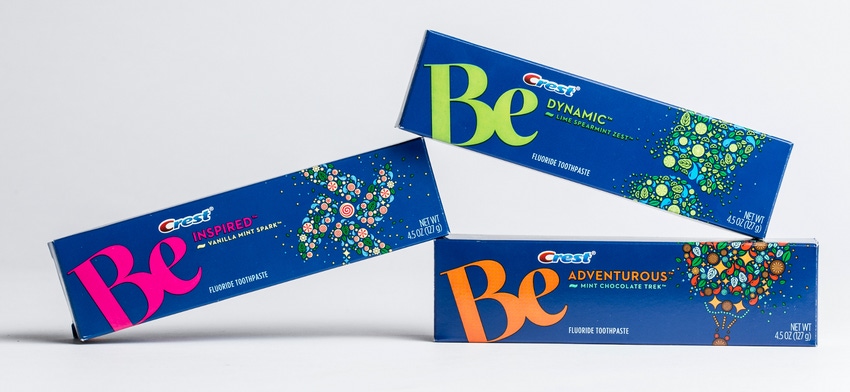The era of feel-good packaging
August 18, 2014

Brands are telling consumers how they will feel if they buy their product—and are doing it front and center on their packages.
Maybe it’s me, but it seems like everywhere you look these days, there’s bad news: war, domestic shootings, political unrest, Middle East Respiratory Syndrome (okay, so that was a false alarm, but still…). With headlines like these, is it any wonder that people are grasping for positivity wherever they can find it? Not surprisingly, Pharrell Williams’ “Happy” song is the anthem of 2014, the one that got Meryl Streep dancing in the aisles at the Oscars. Pharrell is proud to tell everyone that he’s happy, and you should be too, dammit.
Pop songs have no problem telling you how you should be feeling, and now brands are following suit by staging end benefits front and center on pack. A recent trip down the supermarket aisle proves how brands are leveraging this strategy. Several can be seen using a strong end benefit to make the consumer believe they need to buy these products to feel better about life. To feel refreshed, optimistic, energized and—you guessed it—happy. Instead of human behavior driving brands, as they once did, it now seems that brands are the ones driving human behavior.
And when I say they are “on pack,” I’m not saying that these messages are simply tertiary copy buried beneath a brand, sub-brand or claim. In many instances, the end benefits are promoted prominently, and have even become part of the brand name.
Crest recently launched a new line, “Be,” that lets consumers define themselves based on the products they are using. Forget about getting clean teeth and fresh breath—now, you can recalibrate your psyche with just one brush! Be INSPIRED, in a Vanilla Mint Spark flavor, is for those who feel their dental routine is a little, well, underwhelming. Be ADVENTUROUS, in a Mint Chocolate Trek flavor, takes your mouth on an exhilarating ride. And Be DYNAMIC, with its unusual Lime Spearmint Zest combination, tingles the senses with bold and unexpected flavors. The thing that gets consumers’ attention is the prominent sub-brand “Be”; and the end benefit that follows reinforces who and what they should be (inspired, adventurous, dynamic). Crest believes that the emphasis on the potential of what one could be will ultimately drive sales.
Dietary supplement brand, Neuro, prominently features its end benefit front and center on its bottles. In fact, this benefit is so much larger than the actual brand name that you might think that SLEEP (with the tagline “Sweet Dreams”) is the brand, rather than a sub-brand. With this approach, Neuro is trying to lure consumers who are looking for an end benefit, not a specific brand. It’s a great strategy because who wouldn’t be attracted to a product that has the ability to change one’s behavior for the better? Hell, any drink that would help me sleep more soundly is one I’d happily give a shot.
I have to admit, there’s something incredibly appealing about a brand trying to enhance my well-being. But I also can’t help but wonder: Is it realistic to expect a brand to make us feel a certain way about ourselves? Most people would say no, but in a time when books like “The Happiness Project” put a premium on feeling happy, I guess my response is: Why not? After all, Coca-Cola, Apple and Betty Crocker—three of the biggest brand names of our time—have been asking us to feel and behave in certain ways for years, but have limited the use of these messages to their advertising campaigns.
“Have a Coke and a Smile”—a slogan that embodied Coke’s M.O. to spread happiness around the world—has appeared in Coke ads and on promotional collateral for years but rarely on actual bottles. Ditto for Apple, who used “Think Different” in its groundbreaking ad campaign, and put the letter “i” before its product names. (They claim the “i” stands for “interactive,” but there’s no question it also references the individual who puts his/her own stamp on whatever Apple device they are using.) For years, Betty Crocker inspired consumers to “Bake Someone Happy.” What heartless soul wouldn’t bake a dozen cupcakes to make their kids smile?
So, at the end of the day, I wholeheartedly welcome this movement. It’s a lot easier and cheaper than paying a therapist $200 an hour to have you vent about your emotions or complain about why you’re not sleeping at night.
I can’t wait for the day when I can buy a shampoo that will make me feel more creative or use a deodorant that not only helps with perspiration but also makes me feel like a better parent. Soon, we might not even need to analyze how we’re feeling at all—the brands can just do that for us. And singers like Pharrell, of course.
Rick Barrack, chief creative officer/partner, is the lead creative force and one of the founding partners of CBX (www.cbx.com), where he is responsible for inspiring, directing and motivating the company’s creative teams to develop powerful design solutions. He has about 20 years of experience in corporate identity and consumer brand identity design. Contact Barrack at [email protected].
About the Author(s)
You May Also Like


